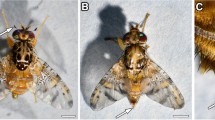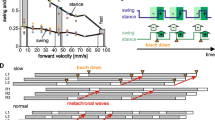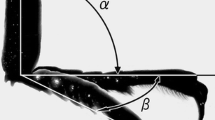Abstract
Previous studies have demonstrated that myofibrillar ATPase (mATPase) enzyme activity in muscle fibers determines their contraction properties. We analyzed mATPase activities in muscles of the front, middle and hind legs of the orthopteran stick insect (Carausius morosus) to test the hypothesis that differences in muscle fiber types and distributions reflected differences in their behavioral functions. Our data show that all muscles are composed of at least three fiber types, fast, intermediate and slow, and demonstrate that: (1) in the femoral muscles (extensor and flexor tibiae) of all legs, the number of fast fibers decreases from proximal to distal, with a concomitant increase in the number of slow fibers. (2) The swing phase muscles protractor coxae and levator trochanteris, have smaller percentages of slow fibers compared to the antagonist stance muscles retractor coxae and depressor trochanteris. (3) The percentage of slow fibers in the retractor coxae and depressor trochanteris increases significantly from front to hind legs. These results suggest that fiber-type distribution in leg muscles of insects is not identical across leg muscles but tuned towards the specific function of a given muscle in the locomotor system.





Similar content being viewed by others
References
Barany M (1967) ATPase activity of myosin correlated with speed of muscle shortening. J Gen Physiol 50:197–218
Barnard RJ, Edgerton VR, Furukawa T, Peter JB (1971) Histochemical, biochemical and contractile properties of red, white and intermediate fibers. Am J Physiol 220:410–414
Bässler U (1967) Zur Regelung der Stellung des Femur-Tibia-Gelenkes bei der Stabheuschrecke Carausius morosus in der Ruhe und im Lauf. Kybernetik 4:18–26
Bässler U (1974) Vom femoralen Chordotonalorgan gesteuerte Reaktionen bei der Stabheuschrecke Carausius morosus: Messung der von der Tibia erzeugten Kraft im aktiven und inaktiven Tier. Kybernetik 16:213–226
Bässler U (1993) The femur–tibia control system of stick insects—a model system for the study of the neural basis of joint control. Brain Res Brain Res Rev 18:207–226
Bässler U, Stein W (1996) Contributions of structure and innervation pattern of the stick insect extensor tibiae muscle to the filter characteristics of the muscle-joint system. J Exp Biol 199:2185–2198
Bässler D, Büschges A, Meditz S, Bässler U (1996) Correlation between muscle structure and filter characteristics of the muscle-joint system in three orthopteran insect species. J Exp Biol 199:2169–2183
Berg E, Büschges A, Schmidt J (2013) Single perturbations cause sustained changes in searching behavior in stick insects. J Exp Biol 216:1064–1074
Blümel M, Guschlbauer C, Daun-Gruhn S, Hooper SL, Büschges A (2012a) Hill-type muscle model parameters determined from experiments on single muscles show large animal-to-animal variation. Biol Cybern 106:559–571
Blümel M, Guschlbauer C, Hooper SL, Büschges A (2012b) Using individual-muscle specific instead of across-muscle mean data halves muscle simulation error. Biol Cybern 106:573–585
Blümel M, Hooper SL, Guschlbauer C, White WE, Büschges A (2012c) Determining all parameters necessary to build Hill-type muscle models from experiments on single muscles. Biol Cybern 106:543–558
Bottinelli R, Reggiani C (2000) Human skeletal muscle fibres: molecular and functional diversity. Progr Biophys Mol Biol 73:195–262
Bottinelli R, Schiaffino S, Reggiani C (1991) Force-velocity relations and myosin heavy chain isoform compositions of skinned fibres from rat skeletal muscle. J Physiol 437:655–672
Bottinelli R, Betto R, Schiaffino S, Reggiani C (1994) Maximum shortening velocity and coexistence of myosin heavy chain isoforms in single skinned fast fibres of rat skeletal muscle. J Muscle Res Cell Motil 15:413–419
Brooke MH, Kaiser KK (1970) Three “myosin adenosine triphosphatase” systems: the nature of their pH lability and sulfhydryl dependence. J Histochem Cytochem 18:670–672
Brunn DE (1998) Cooperative mechanisms between leg joints of Carausius morosus I. Nonspiking interneurons that contribute to interjoint coordination. J Neurophysiol 79:2964–2976
Brunn DE, Heuer A (1998) Cooperative mechanisms between leg joints of Carausius morosus II. Motor neuron activity and influence of conditional bursting interneuron. J Neurophysiol 79:2977–2985
Büschges A (2005) Sensory control and organization of neural networks mediating coordination of multisegmental organs for locomotion. J Neurophysiol 93:1127–1135
Büschges A, Wolf H (1995) Nonspiking local interneurons in insect leg motor control. I. Common layout and species-specific response properties of femur–tibia joint control pathways in stick insect and locust. J Neurophysiol 73:1843–1860
Büschges A, Kittmann R, Schmitz J (1994) Identified nonspiking interneurons in leg reflexes and during walking in the stick insect. J Comp Physiol A 174:685–700
Cooper RL, Marin L, Atwood HL (1995) Synaptic differentiation of a single motor neuron: conjoint definition of transmitter release, presynaptic calcium signals, and ultrastructure. J Neurosci 15:4209–4222
Costello WJ, Govind CK (1984) Contractile proteins of fast and slow fibers during differentiation of lobster claw muscle. Dev Biol 104:434–440
Cruse H (1976) The function of the legs in the free walking stick insect, Carausius morosus. J Comp Physiol A 112:235–262
Cruse H, Schmitz J, Braun U, Schweins A (1993) Control of body height in a stick insect walking on a treadwheel. J Exp Biol 181:141–155
Dallmann CJ, Dürr V, Schmitz J (2016) Joint torques in a freely walking insect reveal distinct functions of leg joints in propulsion and posture control. Proc R Soc B 283:20151708. doi:10.1098/rspb.2015.1708
Dürr V, Ebeling W (2005) The behavioural transition from straight to curve walking: kinetics of leg movement parameters and the initiation of turning. J Exp Biol 208:2237–2252
Epstein S, Graham D (1983) Behaviour and motor output of stick insects walking on a slippery surface. I. Forward walking. J Exp Biol 105:215–229
Fowler WS, Neil DM (1992) Histochemical heterogeneity of fibers in the abdominal superficial flexor muscles of the Norway lobster, Nephrops norvegicus (L.). J Exp Zool 264:406–418
Full R, Ahn A (1995) Static forces and moments generated in the insect leg: comparison of a three-dimensional musculo-skeletal computer model with experimental measurements. J Exp Biol 198:1285–1298
Gabriel JP, Büschges A (2007) Control of stepping velocity in a single insect leg during walking. Philos Trans R Soc A 365:251–271
Gabriel JP, Scharstein H, Schmidt J, Büschges A (2003) Control of flexor motoneuron activity during single leg walking of the stick insect on an electronically controlled treadwheel. J Neurobiol 56:237–251
Galler S, Rathmayer W (1992) Shortening velocity and force/pCa relationship in skinned crab muscle fibres of different types. Pflügers Arch 420:187–193
Galler S, Schmitt TL, Pette D (1994) Stretch activation, unloaded shortening velocity, and myosin heavy chain isoforms of rat skeletal muscle fibres. J Physiol 478:513–521
Galler S, Hilber K, Gohlsch B, Pette D (1997) Two functionally distinct myosin heavy chain isoforms in slow skeletal muscle fibres. FEBS Lett 410:150–152
Goldammer J, Büschges A, Schmidt J (2012) Motoneurons, DUM cells, and sensory neurons in an insect thoracic ganglion: a tracing study in the stick insect Carausius morosus. J Comp Neurol 520:230–257
Govind CK, Kent KS (1982) Transformation of fast fibres to slow prevented by lack of activity in developing lobster muscle. Nature 298:755–757
Grabowska M, Godlewska E, Schmidt J, Daun-Gruhn S (2012) Quadrupedal gaits in hexapod animals: inter-leg coordination in free-walking adult stick insects. J Exp Biol 215:4255–4266
Graham D (1985) Pattern and control of walking in insects. In: Adv Insect Physiol. Academic Press, London, pp 31–140
Graham D, Bässler U (1981) Effects of afference sign reversal on motor activity in walking stick insects (Carausius morosus). J Exp Biol 91:179–193
Gruhn M, Rathmayer W (2002) Phenotype plasticity in postural muscles of the crayfish Orconectes limosus Raf.: correlation of myofibrillar ATPase-based fiber typing with electrophysiological fiber properties and the effect of chronic nerve stimulation. J Exp Zool 293:127–140
Gruhn M, von Uckermann G, Westmark S, Wosnitza A, Büschges A, Borgmann A (2009a) Control of stepping velocity in the stick insect Carausius morosus. J Neurophysiol 102:1180–1192
Gruhn M, Zehl L, Büschges A (2009b) Straight walking and turning on a slippery surface. J Exp Biol 212:194–209
Gruhn M, Rosenbaum P, Bockemühl T, Büschges A (2016) Body side-specific control of motor activity during turning in a walking animal. eLife 5:e13799
Günzel D, Galler S, Rathmayer W (1993) Fibre heterogeneity in the closer and opener muscles of crayfish walking legs. J Exp Biol 175:267–281
Guschlbauer C, Scharstein H, Büschges A (2007) The extensor tibiae muscle of the stick insect: biomechanical properties of an insect walking leg muscle. J Exp Biol 210:1092–1108
Guth L, Samaha FJ (1969) Qualitative differences between actomyosin ATPase of slow and fast mammalian muscle. Exp Neurol 25:138–152
Guth L, Samaha FJ (1970) Procedure for the histochemical demonstration of actomyosin ATPase. Exp Neurol 28:365–367
Hämalainen N, Pette D (1993) The histochemical profiles of fast fiber types IIB, IID, and IIA in skeletal muscles of mouse, rat, and rabbit. J Histochem Cytochem 41:733–743
Hooper SL, Thuma JB (2005) Invertebrate muscles: muscle specific genes and proteins. Physiol Rev 85:1001–1060
Hooper SL, Guschlbauer C, von Uckermann G, Büschges A (2007a) Different motor neuron spike patterns produce contractions with very similar rises in graded slow muscles. J Neurophysiol 97:1428–1444
Hooper SL, Guschlbauer C, von Uckermann G, Büschges A (2007b) Slow temporal filtering may largely explain the transformation of stick insect (Carausius morosus) extensor motor neuron activity into muscle movement. J Neurophysiol 98:1718–1732
Hooper SL, Guschlbauer C, Blümel M, Rosenbaum P, Gruhn M, Akay T, Büschges A (2009) Neural control of unloaded leg posture and of leg swing in stick insect, cockroach, and mouse differs from that in larger animals. J Neurosci 29:4109–4119
Igelmund P (1980) Untersuchungen zur Stellungs- und Bewegungsregelung der Beine der Stabheuschrecke Carausius morosus: Neuronale Grundlagen der Pro- und Retraktion der Coxa (thesis, in German). Universität zu Köln
Iles JF, Pearson KG (1971) Coxal depressor muscles of the cockroach and the role of peripheral inhibition. J Exp Biol 55:151–164
Jahromi SS, Atwood HL (1969) Correlation of structure, speed of contraction, and total tension in fast and slow abdominal muscle fibers of the lobster (Homarus americanus). J Exp Zool 171:25–38
LaFramboise WA, Griffis B, Bonner P, Warren W, Scalise D, Guthrie RD, Cooper RL (2000) Muscle type-specific myosin isoforms in crustacean muscles. J Exp Zool 286:36–48
Maier L, Rathmayer W, Pette D (1984) pH lability of myosin ATPase activity permits discrimination of different muscle fibre types in crustaceans. Histochemistry 81:75–77
Maier L, Pette D, Rathmayer W (1986) Enzyme activities in single electrophysiologically identified crab muscle fibres. J Physiol (Lond) 371:191–199
Marquardt F (1940) Beiträge zur Anatomie der Muskulatur und der peripheren Nerven von Carausius (Dixipus) morosus. Zool Jahrb Abt Anat Ont Tiere 66:63–128
Mentel T, Weiler V, Büschges A, Pflüger HJ (2008) Activity of neuromodulatory neurones during stepping of a single insect leg. J Insect Physiol 54:51–61
Müller AR, Wolf H, Galler S, Rathmayer W (1992) Correlation of electrophysiological, histochemical, and mechanical properties in fibres of the coxa rotator muscle of the locust, Locusta migratoria. J Comp Physiol B 162:5–15
Mykles DL (1997) Crustacean muscle plasticity: molecular mechanisms determining mass and contractile properties. Comp Biochem Physiol B 117:367–378
Ogonowski MM, Lang F, Govind CK (1980) Histochemistry of lobster claw-closer muscles during development. J Exp Zool 213:359–367
Padykula HA, Herman E (1955) Factors affecting the activity of adenosine triphosphatase and other phosphatases as measured by histochemical techniques. J Histochem Cytochem 3:161–169
Pearson KG, Iles JF (1970) Discharge patterns of coxal levator and depressor motoneurones of the cockroach, Periplaneta americana. J Exp Biol 52:139–165
Peckham M, Molloy JE, Sparrow JC, White DC (1990) Physiological properties of the dorsal longitudinal flight muscle and the tergal depressor of the trochanter muscle of Drosophila melanogaster. J Muscle Res Cell Motil 11:203–215
Pette D, Staron RS (1988) Molecular basis of the phenotypic characteristics of mammalian muscle fibres. Ciba Found Symp 138:22–34
Pette D, Vrbová G (1992) Adaptation of mammalian skeletal muscle fibers to chronic electrical stimulation (review). Rev Physiol Biochem Pharmacol 120:115–202
Pilehvarian AA (2015) An ultrastructural and histochemical study of the flexor tibialis muscle fiber types in male and female stick insects (Eurycantha calcarata, L). J Exp Zool 323:527–539
Rathmayer W, Maier L (1987) Muscle fiber types in crabs: studies on single identified muscle fibers. Integr Comp Biol 27:1067–1077
Rivero JL, Talmadge RJ, Edgerton VR (1996) Correlation between myofibrillar ATPase activity and myosin heavy chain composition in equine skeletal muscle and the influence of training. Anat Rec 246:195–207
Rosenbaum P, Wosnitza A, Büschges A, Gruhn M (2010) Activity patterns and timing of muscle activity in the forward walking and backward walking stick insect Carausius morosus. J Neurophysiol 104:1681–1695
Sasaki K, Burrows M (1998) Innervation pattern of a pool of nine excitatory motor neurons in the flexor tibiae muscle of a locust hind leg. J Exp Biol 201:1885–1893
Schmitz J (1986) The depressor trochanteris motoneurones and their role in the coxo-trochanteral feedback loop in the stick insect Carausius morosus. Biol Cybern 55:25–34
Schmitz J, Dallmann CJ (2014) Force and torque profiles of stick insects walking on compliant surfaces. In: Annual meeting of the society of neuroscience (SfN), Washington, DC, USA
Sherman RG, Atwood HL (1972) Correlated electrophysiological and ultrastructural studies of a crustacean motor unit. J Gen Physiol 59:586–615
Silverman H, Costello WJ, Mykles DL (1987) Morphological fiber type correlates of physiological and biochemical properties in crustacean muscle. Integr Comp Biol 27:1011–1019
Staron RS, Pette D (1986) Correlation between myofibrillar ATPase activity and myosin heavy chain composition in rabbit muscle fibers. Histochemistry 86:19–23
Staron RS, Pette D (1987) Nonuniform myosin expression along single fibers of chronically stimulated and contralateral rabbit tibialis anterior muscles. Pflügers Arch 409:67–73
Stokes DR (1987) Insect muscles innervated by single motoneurons: structural and biochemical features. Integr Comp Biol 27:1001–1010
Termin A, Staron RS, Pette D (1989) Myosin heavy chain isoforms in histochemically defined fiber types of rat muscle. Histochemistry 92:453–457
Theunissen LM, Bekemeier HH, Dürr V (2015) Comparative whole-body kinematics of closely related insect species with different body morphology. J Exp Biol 218:340–352
Toth TI, Grabowska M, Schmidt J, Büschges A, Daun-Gruhn S (2013a) A neuro-mechanical model explaining the physiological role of fast and slow muscle fibres at stop and start of stepping of an insect leg. PLoS One 8:e78246
Toth TI, Schmidt J, Büschges A, Daun-Gruhn S (2013b) A neuro-mechanical model of a single leg joint highlighting the basic physiological role of fast and slow muscle fibres of an insect muscle system. PLoS One 8:e78247
von Uckermann G, Büschges A (2009) Premotor interneurons in the local control of stepping motor output for the stick insect single middle leg. J Neurophysiol 102:1956–1975
Walklate J, Ujfalusi Z, Geeves MA (2016) Myosin isoforms and the mechanochemical cross-bridge cycle. J Exp Biol 219:168–174
Acknowledgements
We thank Drs. Joachim Schmidt, Sabine Kreissl, Tibor Toth, Till Bockemühl and Christoph Guschlbauer for valuable comments and discussions and Sabine Kreissl for additionally providing valuable equipment for the mATPase histochemistry, and Till Bockemühl for help with data analysis.
Author information
Authors and Affiliations
Corresponding author
Ethics declarations
Funding
This work was supported by Konrad-Adenauer Foundation to E. Godlewska-Hammel and Deutsche Forschungsgemeinschaft DFG Grant Bu857/14.
Conflict of interest
The authors declare that they have no conflict of interest.
Ethical approval
All applicable international, national, and/or institutional guidelines for the care and use of animals were followed.
Rights and permissions
About this article
Cite this article
Godlewska-Hammel, E., Büschges, A. & Gruhn, M. Fiber-type distribution in insect leg muscles parallels similarities and differences in the functional role of insect walking legs. J Comp Physiol A 203, 773–790 (2017). https://doi.org/10.1007/s00359-017-1190-8
Received:
Revised:
Accepted:
Published:
Issue Date:
DOI: https://doi.org/10.1007/s00359-017-1190-8




